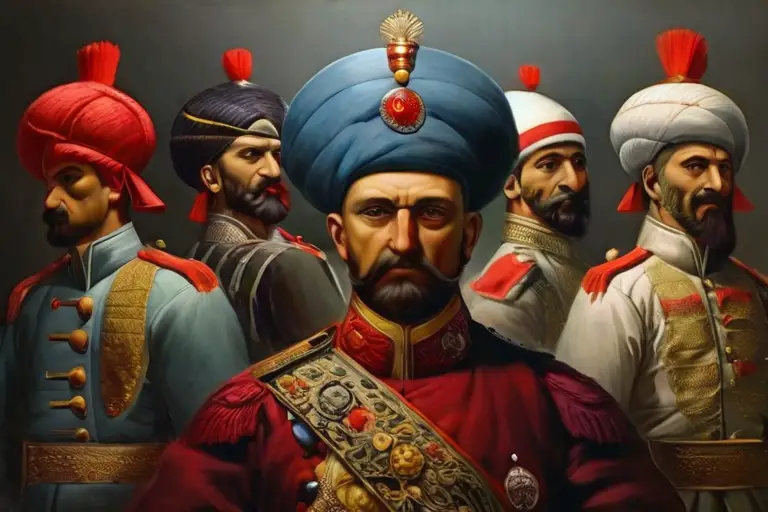
The Ottoman Empire, one of the most powerful and influential states in history, has left a lasting impact on the world.
From its humble beginnings in the 13th century to its dissolution in the 20th century, the empire’s rich history is filled with fascinating facts and stories.
In this article, we will explore 15 compelling facts about the Ottoman Empire, shedding light on its rise, peak, and legacy.
15 Facts About the Ottoman Empire
Founding and duration
The Ottoman Empire, established in 1299 by Osman I, stood as a formidable entity for over six centuries, marking its dissolution in 1922.
This extensive lifespan showcased the empire’s endurance and resilience in the face of changing geopolitical landscapes.
- Read also: A Journey Through the Persian Empire Timeline
- Read also: The Rise and Fall of the Roman Empire
Territorial expansion
Originating as a modest state in Anatolia, the Ottoman Empire experienced remarkable territorial expansion.
Its dominion expanded across the Middle East, southeastern Europe, and North Africa, reaching its zenith between the 1480s and the 1560s.
The empire’s growth underscored its strategic prowess and influence on a global scale.

Religious and cultural diversity
One of the Ottoman Empire’s distinctive features was its rich tapestry of religious and cultural diversity.
Embracing a mosaic of ethnic and religious groups, including Muslims, Christians, and Jews, the empire fostered a unique environment of coexistence.
This inclusive approach contributed to the development of a multi-ethnic and multi-religious society, showcasing a remarkable level of tolerance for its time.
Capital cities
Throughout its existence, the Ottoman Empire shifted its capital cities, each playing a significant role in different periods.
Bursa, Edirne, and Constantinople (later renamed Istanbul) all served as centers of power.
Constantinople, in particular, retained its status as the capital until the empire’s eventual collapse.
These changes in capitals reflected the empire’s adaptability and strategic considerations over the centuries.
Suleiman the magnificent
The reign of Suleiman the Magnificent, spanning from 1520 to 1566, stands out as a pinnacle in the Ottoman Empire’s history.
Under his leadership, the empire expanded its influence to encompass vast territories in Eastern Europe, Greece, and parts of North Africa.
Suleiman’s era is often regarded as a period of cultural and economic flourishing, earning him the epithet “the Magnificent.”
Military power
The Ottoman Empire was renowned for its formidable military force, with the elite Janissaries standing as a symbol of its strength.
The military prowess played a pivotal role in the empire’s territorial expansion and global influence, establishing the Ottomans as a dominant force during their peak.
Tanzimat reforms
In an effort to modernize, the Ottoman Empire initiated the Tanzimat reforms from 1839 to 1876.
These reforms aimed to bring about political, legal, and administrative changes.
However, the pace of implementation was gradual, and the reforms struggled to keep up with the rapidly changing global landscape.
This slow pace ultimately contributed to the empire’s decline as it faced internal and external challenges.
Cultural legacy
Despite its decline, the Ottoman Empire left an enduring cultural legacy, especially evident in Turkish culture and the historical landscape of Istanbul.
The city, once the empire’s capital known as Constantinople, continues to bear the marks of Ottoman architecture, art, and traditions, serving as a testament to its historical significance.
End of World War I
The aftermath of World War I marked a significant turning point for the Ottoman Empire.
As the empire sided with the Central Powers and faced defeat, it crumbled, leading to the establishment of the Republic of Turkey in 1923 under the leadership of Mustafa Kemal Atatürk.
This event signaled the end of the Ottoman Empire, concluding a chapter in history that spanned over six centuries.
Influence on Southeast Europe and Middle East
At its zenith, the Ottoman Empire stretched across most of southeastern Europe, parts of the Middle East, and North Africa.
This expansive influence left an indelible mark on the history and culture of the regions it once governed.
The Ottoman legacy is visible in diverse aspects, from architectural marvels to cultural practices, shaping the identity of the Southeast European and Middle Eastern nations.

Founder
The Ottoman Empire traces its roots to Osman I, born in 1258 in Anatolia, which is modern-day Turkey.
Osman I played a pivotal role in leading a group of Turks against the Byzantines, ultimately laying the foundation for the Ottoman state.
His leadership marked the initiation of a dynasty that would shape the course of history for over six centuries.
Decline and wars with European leaders
In the latter decades of the 1500s, the Ottoman Empire entered a period of decline.
This decline was characterized by conflicts with European leaders, resulting in the loss of substantial territories.
Wars waged with European powers contributed to the weakening of the empire’s influence, marking a challenging phase in its history.
Legacy of the name
The term “Ottoman” holds a significant historical lineage, deriving from Osman I, the visionary leader who founded both the dynasty and the empire around 1300.
The dynastic appellation became synonymous with a powerful and enduring legacy that extended for centuries, leaving an indelible mark on the regions it governed.
Influence on Turkish culture
The Ottoman period, spanning over 600 years until its dissolution in 1922, wielded a profound influence on Turkish culture and history.
The empire’s impact is evident in various aspects of Turkish life, including architecture, art, cuisine, and governance.
The imprint of the Ottoman legacy remains embedded in the cultural fabric of modern-day Turkey.
Ancestors of Osman I
Osman I’s lineage is rooted in the Kayı tribe, whose members entered Anatolia alongside a mass of Turkmen Oğuz nomads.
Prior to Osman’s leadership, his ancestors had established themselves as the Seljuq dynasty in Iran and Mesopotamia during the mid-11th century.
This historical context illuminates the tribal and nomadic origins that set the stage for the emergence of the Ottoman Empire.

- Read also: Egyptian Empire Timeline
- Read also: A Journey Through Babylonian Empire Timeline
Conclusion
The narrative of the Ottoman Empire unfolds as a captivating saga of ascent, territorial expansion, and eventual decline.
Through its rich and influential culture, formidable military prowess, and a lasting legacy, the empire has undeniably shaped the course of history.
Delving into these 15 facts offers a profound insight into the empire’s historical significance and the enduring imprint it has left on the global stage.
Explore these facets to gain a deeper understanding of the Ottoman Empire’s profound impact and its lasting legacy in the world.


